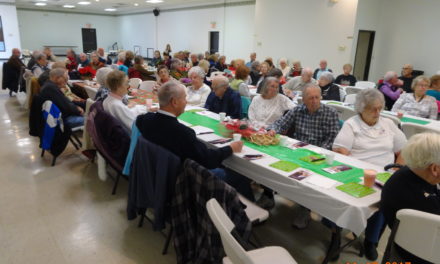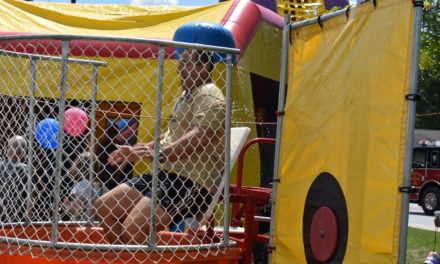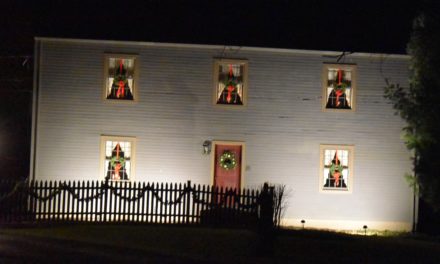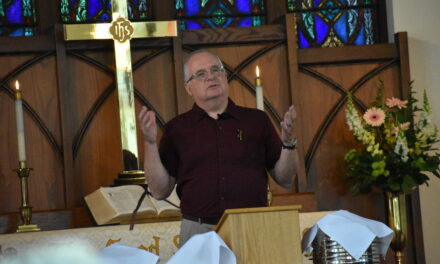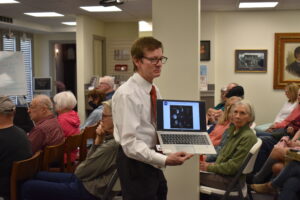
NASA aerospace engineer Craig Williams holds a computer showing the phases of the moon at his presentation on the April 8 solar eclipse.
Solar eclipses are a rare phenomena to begin with. With all the oceans, mountains and deserts on earth, it’s even less likely that an individual can see one at all.
That’s what makes the April 8 total solar eclipse across a wide swath of the populated U.S. such a treat for those who care about such things, said NASA Glenn Research Center aerospace engineer Craig Williams.
Trumbull County will be in the path of partial totality on April 8. The eclipse will start at about 3:15 p.m. in Brookfield and last about 1 ½ minutes.
Williams, speaking March 23 at the McKinley Birthplace Home in Niles, marveled at all the things that had to happen in order for an eclipse to occur. First, the moon has to be in the new moon position, meaning its visibility is totally obscured by the sun. Second, the planes of the moon and sun, which are not identical, have to intersect.
Lastly, “This goes back to your trigonometry: The tangent of an angle is opposite over adjacent,” Williams said. “The perceived radius of the moon at the distance that it is from us, the tangent of that angle is about the same as the tangent of the angle of the perceived radius of the sun at the distance it is at. What are the chances of those four numbers all lining up that way, so that it’s exactly the same? What a wild thing to have happen by pure chance.”
A total solar eclipse happens on earth every 1.5 years. Since the founding of the United States in 1776, there have been only 21 total solar eclipses visible in the country. The last total solar eclipse visible in Ohio was in 1806, and the next one will be in 75 years.
“Bottom line is – don’t miss it,” Williams said. “If you snooze, you lose, and that would be a shame.”
@ @ @
Please help support NEWS On the Green’s work:
Click here: http://news-on-the-green.fundjournalism.org/news-on-the-green-page-1
Sure, the eclipse is cool, but it’s not just something to use as an excuse to get out of school or work early. A lot of serious scientific study will be going on. Science foundations are pouring money into studies, and amateur astronomers are being sought to contribute to these efforts, Williams said.
“An eclipse is caused by the moon but all the scientists are focusing on is the sun,” he said. “The corona is being studied during an eclipse because the moon is blocking out this blazing disc of the sun and you can finally see what’s going on in the atmosphere. It’s that atmosphere that interacts with our atmosphere (and) that’s the main reason why we’re interested.”
The corona can best be seen during an eclipse, “and some parts of the science can only be done by looking at it during an eclipse,” Williams said. “Satellites cannot do it all.”
Scientists will study the physical properties of the corona and the solar wind, the charged particles that race from the sun into space and can be thousands of miles in length, he said. The sun will be near solar max, it’s most active time period, something that happens about every 11 years, at the time of the eclipse, he said.
The end game is to determine how the sun impacts the earth’s atmosphere and drives its climate, Williams said.
“The good news is, this is a remarkable thing happening in our back yard,” he said. “The bad news is, it’s happening in our back yard in the springtime.”
Yet, even if it’s overcast on April 8, “You can turn it into a giant science experiment,” Williams said.
He suggested taking temperature readings and pressure readings every 10 seconds, and measuring ambient light, if you have a meter.
“It’s gonna get dark,” Williams said, noting that nocturnal animals might wake up. “Even if it’s cloudy, it’s gonna get dark.”
Williams warned that viewers need eclipse glasses to watch the happenings with their eyes, plus they should not look at the eclipse with binoculars or a telescope while wearing eclipse glasses. “That just concentrates the light and overwhelms the glasses, even if you’re wearing them correctly,” he said.
Make sure the eclipse glasses are in good condition – no cuts in the lenses – and are not old.
Buhl Park in Hermitage, Westminster College in New Wilmington, Pa., and the Warren-Trumbull County Public Library are holding viewing celebrations – with the library’s at Mollenkopf Stadium in Warren.
Trumbull County Tourism Bureau lists other activities at www.TrumbullEclipse.com The Ohio Department of Health has eclipse viewing tips on its website.

